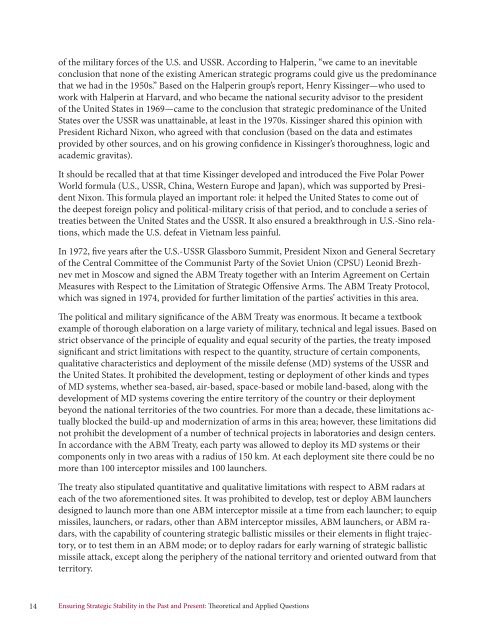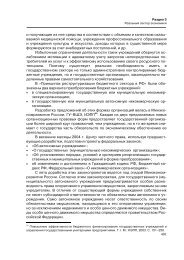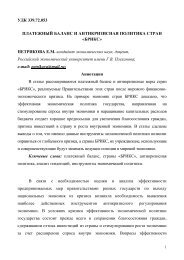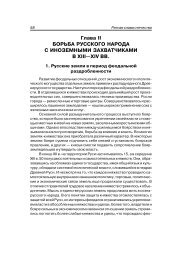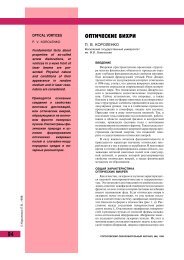Ensuring Strategic Stability in the Past and Present:
Ensuring Strategic Stability in the Past and Present:
Ensuring Strategic Stability in the Past and Present:
You also want an ePaper? Increase the reach of your titles
YUMPU automatically turns print PDFs into web optimized ePapers that Google loves.
of <strong>the</strong> military forces of <strong>the</strong> U.S. <strong>and</strong> USSR. Accord<strong>in</strong>g to Halper<strong>in</strong>, “we came to an <strong>in</strong>evitableconclusion that none of <strong>the</strong> exist<strong>in</strong>g American strategic programs could give us <strong>the</strong> predom<strong>in</strong>ancethat we had <strong>in</strong> <strong>the</strong> 1950s.” Based on <strong>the</strong> Halper<strong>in</strong> group’s report, Henry Kiss<strong>in</strong>ger—who used towork with Halper<strong>in</strong> at Harvard, <strong>and</strong> who became <strong>the</strong> national security advisor to <strong>the</strong> presidentof <strong>the</strong> United States <strong>in</strong> 1969—came to <strong>the</strong> conclusion that strategic predom<strong>in</strong>ance of <strong>the</strong> UnitedStates over <strong>the</strong> USSR was unatta<strong>in</strong>able, at least <strong>in</strong> <strong>the</strong> 1970s. Kiss<strong>in</strong>ger shared this op<strong>in</strong>ion withPresident Richard Nixon, who agreed with that conclusion (based on <strong>the</strong> data <strong>and</strong> estimatesprovided by o<strong>the</strong>r sources, <strong>and</strong> on his grow<strong>in</strong>g confidence <strong>in</strong> Kiss<strong>in</strong>ger’s thoroughness, logic <strong>and</strong>academic gravitas).It should be recalled that at that time Kiss<strong>in</strong>ger developed <strong>and</strong> <strong>in</strong>troduced <strong>the</strong> Five Polar PowerWorld formula (U.S., USSR, Ch<strong>in</strong>a, Western Europe <strong>and</strong> Japan), which was supported by PresidentNixon. This formula played an important role: it helped <strong>the</strong> United States to come out of<strong>the</strong> deepest foreign policy <strong>and</strong> political-military crisis of that period, <strong>and</strong> to conclude a series oftreaties between <strong>the</strong> United States <strong>and</strong> <strong>the</strong> USSR. It also ensured a breakthrough <strong>in</strong> U.S.-S<strong>in</strong>o relations,which made <strong>the</strong> U.S. defeat <strong>in</strong> Vietnam less pa<strong>in</strong>ful.In 1972, five years after <strong>the</strong> U.S.-USSR Glassboro Summit, President Nixon <strong>and</strong> General Secretaryof <strong>the</strong> Central Committee of <strong>the</strong> Communist Party of <strong>the</strong> Soviet Union (CPSU) Leonid Brezhnevmet <strong>in</strong> Moscow <strong>and</strong> signed <strong>the</strong> ABM Treaty toge<strong>the</strong>r with an Interim Agreement on Certa<strong>in</strong>Measures with Respect to <strong>the</strong> Limitation of <strong>Strategic</strong> Offensive Arms. The ABM Treaty Protocol,which was signed <strong>in</strong> 1974, provided for fur<strong>the</strong>r limitation of <strong>the</strong> parties’ activities <strong>in</strong> this area.The political <strong>and</strong> military significance of <strong>the</strong> ABM Treaty was enormous. It became a textbookexample of thorough elaboration on a large variety of military, technical <strong>and</strong> legal issues. Based onstrict observance of <strong>the</strong> pr<strong>in</strong>ciple of equality <strong>and</strong> equal security of <strong>the</strong> parties, <strong>the</strong> treaty imposedsignificant <strong>and</strong> strict limitations with respect to <strong>the</strong> quantity, structure of certa<strong>in</strong> components,qualitative characteristics <strong>and</strong> deployment of <strong>the</strong> missile defense (MD) systems of <strong>the</strong> USSR <strong>and</strong><strong>the</strong> United States. It prohibited <strong>the</strong> development, test<strong>in</strong>g or deployment of o<strong>the</strong>r k<strong>in</strong>ds <strong>and</strong> typesof MD systems, whe<strong>the</strong>r sea-based, air-based, space-based or mobile l<strong>and</strong>-based, along with <strong>the</strong>development of MD systems cover<strong>in</strong>g <strong>the</strong> entire territory of <strong>the</strong> country or <strong>the</strong>ir deploymentbeyond <strong>the</strong> national territories of <strong>the</strong> two countries. For more than a decade, <strong>the</strong>se limitations actuallyblocked <strong>the</strong> build-up <strong>and</strong> modernization of arms <strong>in</strong> this area; however, <strong>the</strong>se limitations didnot prohibit <strong>the</strong> development of a number of technical projects <strong>in</strong> laboratories <strong>and</strong> design centers.In accordance with <strong>the</strong> ABM Treaty, each party was allowed to deploy its MD systems or <strong>the</strong>ircomponents only <strong>in</strong> two areas with a radius of 150 km. At each deployment site <strong>the</strong>re could be nomore than 100 <strong>in</strong>terceptor missiles <strong>and</strong> 100 launchers.The treaty also stipulated quantitative <strong>and</strong> qualitative limitations with respect to ABM radars ateach of <strong>the</strong> two aforementioned sites. It was prohibited to develop, test or deploy ABM launchersdesigned to launch more than one ABM <strong>in</strong>terceptor missile at a time from each launcher; to equipmissiles, launchers, or radars, o<strong>the</strong>r than ABM <strong>in</strong>terceptor missiles, ABM launchers, or ABM radars,with <strong>the</strong> capability of counter<strong>in</strong>g strategic ballistic missiles or <strong>the</strong>ir elements <strong>in</strong> flight trajectory,or to test <strong>the</strong>m <strong>in</strong> an ABM mode; or to deploy radars for early warn<strong>in</strong>g of strategic ballisticmissile attack, except along <strong>the</strong> periphery of <strong>the</strong> national territory <strong>and</strong> oriented outward from thatterritory.14<strong>Ensur<strong>in</strong>g</strong> <strong>Strategic</strong> <strong>Stability</strong> <strong>in</strong> <strong>the</strong> <strong>Past</strong> <strong>and</strong> <strong>Present</strong>: Theoretical <strong>and</strong> Applied Questions


